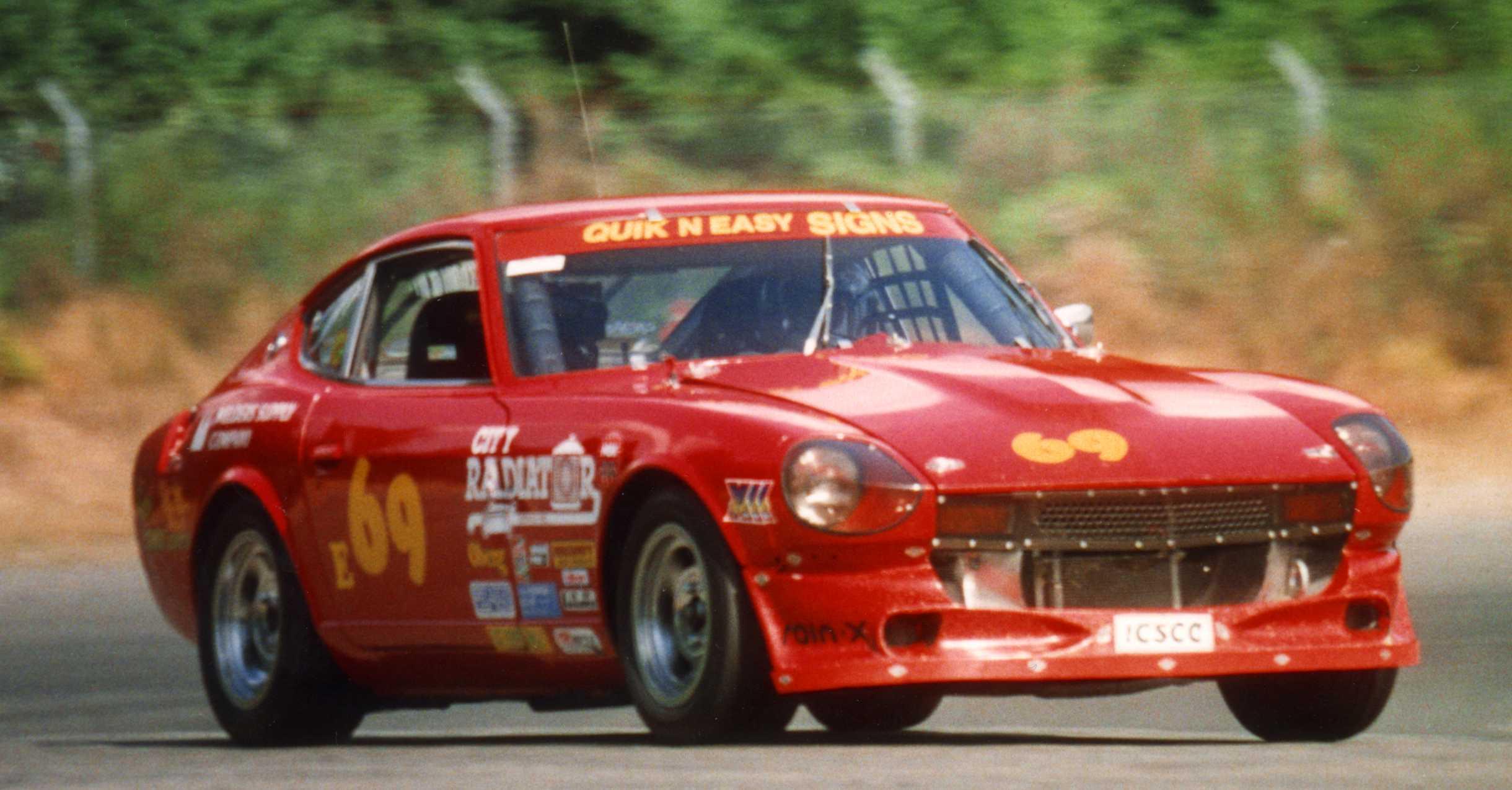
Everything posted by Racer X
-
Z's only a mother could love thread
Peter Max did a ZX!
-
Z's only a mother could love thread
Looks like the towel bar survived, eh?
-
Z's only a mother could love thread
Reminiscent of the Tyrell P34.
-
Z's only a mother could love thread
Someone should take that dope's man card away.
-
Z's on BAT and other places collection
My 72 even has a towel bar on the front bumper. 1972 Datsun 240Z by Racer, on Flickr 1972 Datsun 240Z by Racer, on Flickr I don't like it, and it will be coming off soon. My plan is to get new bumpers with nothing on them, not even the black rubber strips on the outer ends.
-
Z's on BAT and other places collection
I’ll sell you mine.
-
Z's on BAT and other places collection
They are meant to deflect the bumper of another vehicle, keeping it from “overriding” the bumper and damaging the bodywork. But since these cars don’t have heavy frames like the American land yachts of the 40’s, 50’s and 60’s, it doesn’t matter, the frame structure crumples no matter how it gets hit.
-
Z's on BAT and other places collection
Pretty car. The blue is nice. The bottom is rough, but the rust isn't too bad, something that could be deferred for a year or two. It looks like there has been some reinforcing done along the forward frame rails, where the suspension and stabilizer bar mount. And then there is that dent in the lower core support. The air dam should be the same color as the rest of the car too. And ditch those over riders on the bumpers.
-
Local engine builder
He has a great reputation, and has built lots of championship winning engines. The head he did for me has been on two bottom ends I've built, I won a regional championship in 1997 with it, and it is sitting on my bench waiting for another engine to get paired up with.
-
Local engine builder
I sent him an E31 head some years back to mill, put larger valves and seats in, port and flow. My only complaint was the coolant passages were full of chips from the machine work, and they didn’t detail the valve springs. I called to try and address it and the response was I could ship it back at my expense, and he would take a look at it. I just disassembled it, cleaned it out and detailed the springs myself.
-
Local engine builder
Arlington, Washington. Shipping would add significantly to the cost. Too bad you aren’t closer, I could help you out. Dave Rebello is in Antioch, not far from you. Give him a call. Just make sure they detail the valve springs. ( you can tell him I said that too, as it was one of his engines that I mentioned earlier)
-
1976 280 Z from Ohio to Dubai
The repairs are coming along quickly, and looking quite good. Poor Bernie can’t get a break after that shot of him with the mittens and that sour look went viral. I see where the woman who made them is getting plenty of offers to buy them, although it is only a hobby for her. She did provide a few pairs for auction to raise money for some cause though, so a good outcome, eh?
-
Local engine builder
Where are you at?
-
Gas filler recess area
I see you are in Minnesota. They salt the roads in Minnesota, don't they? That lower front corner of the filler pocket can collect dirt, and when it gets wet, it tends to stay wet. Patch in some new metal, or see if you can find a good used part from a parts car. You might use some of the seam sealed to fill that area, after assembly and primer, to direct moisture from collecting there. Then wait for the spring rains to wash the roads off before the first drive of the season every year.
-
1976 280 Z from Ohio to Dubai
Get an auto darkening hood. They can be had pretty cheap these days. I even fitted mine with cheater lenses on the inside so my old eyes can actually see the work.
-
Local engine builder
Be sure he uses the correct cam cover and oil pan gaskets. The cork gaskets are useless, and will start leaking before he pours oil into the engine. No sealer is needed on the cam cover gasket. I used grey silicone (a very thin film, just enough to hold it to the pan), nothing on the cylinder block side, assembled and snugged the bolts finger tight, let it set overnight, then torque to spec. I did this on my first race engine built in 1989, and have reused the pan/gasket on 3 different engines, with no leaks. And I've used the same cam cover gasket along side the pan. Is this mechanic doing the cylinder head too? If so be sure he details the valve springs. When the springs are cut and ground, a sharp edge forms on the ends of the spring wire. A little work with a die grinder fitted with a Scotchbrite hard roll smoothing and polishing the ends will save the spring seat shims, and the retainers from the raw edges that would otherwise cut into them. (I had a fellow racer come up to me at a meet once with a handfull of metal bits and ask me what they were. I told him they were pieces of spring seat shim, and then looked at his valvetrain and pointed out where some of the other ones were starting to come out from under the springs. Being a office worker, engineer as I recall, he paid one of the well known engine builders to build him an engine. I told him he needed to have a talk with them about the poor quality workmanship.) Don't forget the camshaft to cam follower geometry check. Very important. Also a very good idea to use a degree wheel when assembling the engine. crank and cam timing need to be set correctly so a good baseline can be established for further tuning. Do you know what you will be using for cam profile? Are you also looking for some performance gains? There is a lot of detail work that can be done, some to the block, and a lot to the head. Has this engine been reworked before? How many miles are on it? If the cylinders are in good shape, in spec for roundness, size and taper, it is possible that they can be honed, and new pistons and rings used, extending the time to when the block is bored beyond usefulness. If the block deck checks out within spec, leave it be, otherwise only take off the bare minimum to clean it up. The rotating assembly, crank and rods, are forged steel, and everything is balanced very well from the factory. The Datsun engine builders were very proud of their work, and it shows in the excellent quality of these engines. They always need to be checked for balance, the crank along with the flywheel, clutch cover (without the disc), harmonic balancer/pulley and the cam chain gear and distributor/oil pump drive gear. Like with the valve springs, all sharp edges should be cleaned up before assembly, oil holes in the journals, edges of holes drilled for balancing. This prevents the possibility of a stress riser forming, which would result in a fracture of the crank, something that never ends well. If you really want to go all out, polish the rods and crank, to reduce windage losses, polish the inside of the block and paint the it with Glyptal so the oil returns to the pan quicker. The cylinders can be eyebrow notched to unshroud the valves, same on the head. In addition to port matching, there is plenty to gain with a full port job (including manifold carbs and header) and flowbench work. But this all costs a lot of money, as mostly it is a time and material thing, and many hours of labor are involved. I do most of this to the engines I have built, save for the flowbench and porting work, and the stuff that has to happen in a machine shop with mills and boring machines. Saves me thousands of dollars. I've probably left a couple of things out, if I remember them, I'll pop in again. If you have any questions, please ask.
-
Let's show vintage racing pictures. I'll start.
Stumbling around the innerwebZ I came across this. Not much left that is Skyline, the roof, windshield, engine (in a manner of speaking), and that's about it.
-
Let's show vintage racing pictures. I'll start.
Please feel free to share.
-
Z's on BAT and other places collection
A fellow racer had the sister car to this, the Mitsubishi Starion. Turbo 4 cylinder, 5 speed manual. Very fast. We shared it in a 6 hour endurance race, with another guy. The other guy did the first two hours, I did the second stint, then my buddy took over. We were leading in our class, with 20 minutes to go when the head gasket blew. We had enough of a lead that we still finished 3rd.
-
Z Cars
A British friend of mine shared this with me today, after we had a conversation about Z cars. A British crime TV series that started in 1962
-
Timing plates issue
Given the one that goes to 30 has a greater distance from zero to 20 than the one that only goes zero to 20, it would appear that each is made for a different diameter damper pulley. If you have a 280ZX damper, the scale for that setup should be the one to use. If you have a 280Z damper, use the scale for that setup. At different pulley diameters, the length of the arc as the crank rotates changes, i.e. a smaller pulley swings a shorter arc than a larger one for a given amount of rotation. So a larger diameter pulley will require a longer scale to measure degrees of crankshaft rotation. You are only checking crankshaft position with this, so the cylinder head isn't a consideration. Set the crankshaft at #1 top dead center, mount the pointer so the 0 lines up with the mark on the damper, and lock it down. I have never given any consideration to front cover production changes, if any, that may have occurred over the life of the L series engines. So I can't say there would or would't be a difference from the 280Z to the 280ZX. The brackets both look like they have mounting holes at the same distance, and the upper hole is smaller than the lower hole on each one, and both mount under the bolt heads on the lower right two cover bolts, the bottom one being larger diameter than the one above it.
-
Z's on BAT and other places collection
I have a kid brother 10 years younger than me. When he was grown enough to start moving around and explore his new environment he began a weird habit of shoving stuff up his nose. He continued this disgusting habit until he was nearly 4. We quickly learned to grab a washcloth, hold it over his nose and blow gently into his mouth. Popped whatever it was he had crammed up there right out. He always giggled.
-
Z's on BAT and other places collection
From the ad copy for the Black Pearl currently on BAT: “This 1978 Datsun 280Z is one of fewer than 1,500 Black Pearl editions produced for the model’s final production year.“
-
Z's on BAT and other places collection
What is wrong with the manufacturers these days? A sports car is supposed to have a manual transmission. The engineers and designers should have their man cards revoked.
-
Z's on BAT and other places collection
That makes all the difference. It should look a lot better when installed correctly.







